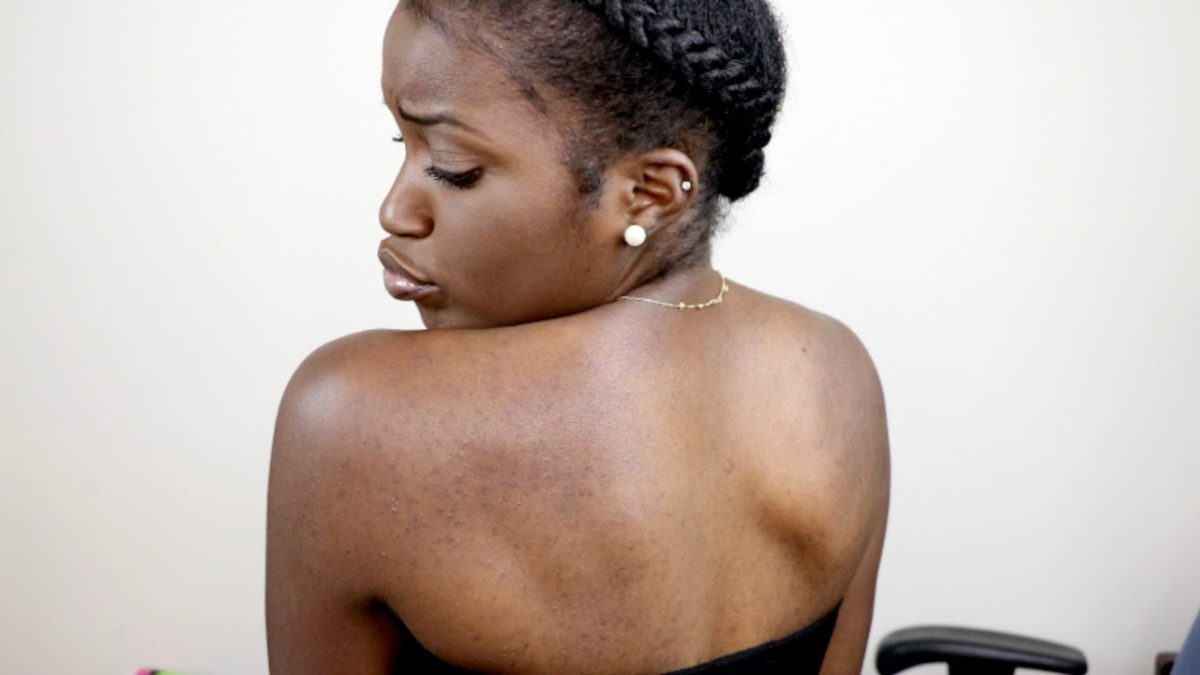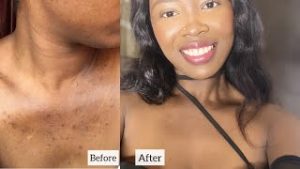
Causes Of Chapped Lips & How To Care For Your Lips
June 3, 2024
How To Use Body Oil For Radiant Skin
June 17, 2024Acne is a common skin condition that nearly everyone will deal with at some point. It’s more common for teenagers, but it can affect people (both men and women) of all ages. Acne also can appear anywhere on your skin where you have oil glands; like your back, face, stomach or chest.
Although acne develops for numerous reasons, it’s often caused by the accumulation of dead skin cells that block your pores and lead to the growth of a specific bacteria that’s present on the skin called propionibacterium acne. As a result, your skin becomes inflamed, leading to whiteheads, blackheads or pimples to form. For this article, we’ll focus on chest acne & back acne.
What Is Chest Acne & Back Acne
Chest acne is simply acne that develops on the chest while back acne (“bacne”) is acne that develops on your back. It occurs when sweat, oil, dead skin cells and bacteria get trapped in your skin’s pores. Things like backpacks, sweaty shirts or sports equipment can create friction on your chest and back areas and worsen chest acne & back acne. You can treat chest acne & back acne by keeping your skin clean and using acne-fighting skin products.
Causes Of Chest Acne & Back Acne
Chest acne & back acne develop like other types of pimples. Your skin’s pores (the tiny holes on your skin) can get clogged with dirt, dead skin cells, sweat and an oil called “sebum”. Your body makes sebum to keep your skin and hair from getting too dry, but if your body makes too much sebum or you don’t clean your skin properly, you can get clogged pores. This can result from:
- Friction – Shirts, backpacks, sporting equipment and other clothing that are tight and rub against sweaty skin can cause or worsen chest acne & back acne.
- Trapped sweat – Sweat can get trapped between your skin and your clothing. When it does, your pores can get clogged. People who have conditions that cause excessive sweating have a higher chance of developing chest acne & back acne.
- Stress and anxiety – When you have a lot of anxiety or stress, your body makes more of the hormone cortisol. As cortisol levels rise, your body produces more sebum which can lead to chest acne & back acne.
- Hormones – People who are pregnant and young people going through adolescent development (puberty) are more likely to get acne breakouts as hormone levels change.
- Medications – Some drugs, including corticosteroids, testosterone or lithium, can cause chest acne & back acne or make it worse.
- Family history – You’re more likely to develop chest acne & back acne if you have a family history of acne.
- Poor hygiene – People with unclean hair can get chest acne & back acne when oils from their hair rub against their back. This type of acne can also result from dirty sheets, towels or clothing.
- Skincare products – Certain lotions and creams can clog pores and lead to acne.
Symptoms Of Chest Acne & Back Acne
Chest acne & back acne can often be painful and may develop in clusters. You might have one type of acne or a combination of them including:
- Blackheads.
- Cysts – which result from a type of acne called cystic acne which form bumps deep below your skin’s surface.
- Nodules – which result from a severe type of acne called nodular acne which form hard lumps under your skin.
- Red bumps that don’t have a “head”.
- Whiteheads.
Prevention Of Chest Acne & Back Acne
You may not be able to prevent every chest and back acne but you can consult your dermatologist for diagnosis on factors that may be causing your chest acne & back acne. You can also lower your risk of getting chest acne & back acne by:
- Changing your clothes after you sweat.
- Bathing after doing sweat-inducing activities like exercises.
- Keeping your skin clean.
- Limiting your use of sports equipment (like football pads) and heavy backpacks.
- Managing your stress levels.
- Using sunscreen.
- Using noncomedogenic products like the range of products from Kanda.
- Wearing loose-fitting, sweat-wicking or cotton shirts.
Treatment Of Chest Acne & Back Acne
There are many ways of treating mild acne at home, including:
- Keep your skin clean – Use an oil-free cleansing product that’s “noncomedogenic,” which means it won’t clog your pores. Shower and change into clean clothes after exercise.
- Don’t scrub your skin – Resist the urge to scrub your skin with harsh cleansers as scrubbing can make acne worse.
- Use clean linens – It’s important to use clean towels, sheets and pillowcases so bacteria don’t build up. Try to wash your sheets and towels at least once a week.
- Use topical creams, gels and cleansers – Benzoyl peroxide products can clear up chest acne & back acne. When using a benzoyl peroxide cleanser, allow the medicine to stay on the acne for up to five minutes before rinsing it off. You may also try a retinoid gel or an acne sticker that releases salicylic acid medication into the acne over several hours.
- Avoid popping or squeezing the pimples – You can damage your skin by popping acne. Squeezing or popping them can also lead to acne scars, which can be severe. Picking at a pimple can also lead to an infected pimple.
If chest acne & back acne lingers or keeps coming back, you need to see your dermatologist. They may recommend other prescription skincare products to treat severe acne or you may need antibiotics or other oral medications.
Products And Ingredients That Treat Chest Acne & Back Acne
While doing the above to treat your chest acne & back acne, you should also explore topical products like the Kanda Acne & Skin Irritation sample pack that contains any of the following:
- Tea tree oil – It is a natural antibacterial and anti-inflammatory, which might kill P. acnes, the bacteria that causes acne. It is the key ingredient in the Kanda Tea Soap.
- Argan oil – It is a noncomedogenic, which can help balance sebum production on oily skin and promote hydration on dry skin.
- Aloe vera – It is a natural antibacterial and anti-inflammatory, meaning it may reduce the appearance of acne and prevent acne breakouts as part of a treatment course.
- Honey – It contains many antioxidants that can help to clear clogged pores.
- Coconut oil – It contains anti-inflammatory and antibacterial compounds that may help eradicate acne-causing bacteria and reduce the redness and swelling of pimples.
When To See A Doctor About Your Acne
You may want to talk with your dermatologist if your acne sores are:
- Unbearably painful,
- Infected,
- Caused by underlying causes like a hormone imbalance or allergies,
- Embedded deep under your skin,
- Not responding to home treatment,
- Covering a large area of skin, and
- Causing you emotional distress.
Caring For Your Acne
Usually, chest acne & back acne get better with at-home treatments, including topical use of natural skincare products. But if your acne doesn’t respond to the above products and other over-the-counter products, your dermatologist should be able to treat severe acne with prescription medications.
Depending on how many pimples you have, you may need to try different types of treatments. It might take several weeks for them to clear up. Your dermatologist may recommend a combination of medications to get the skin results that you desire.



